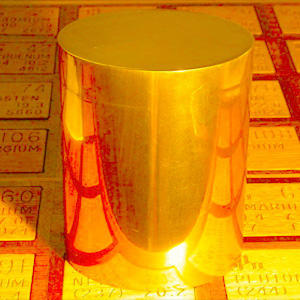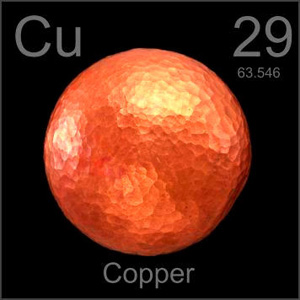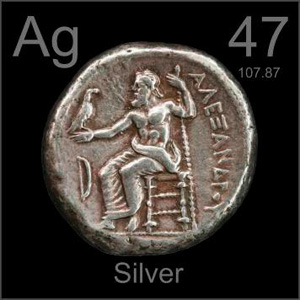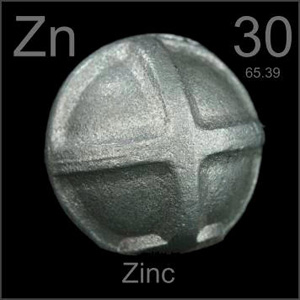Metals are used in every facet of Jewellery design and production for Kimi Designs works of wearable art.
We use elemental metals like aluminum, sterling silver, gold, and copper. We also use the odd alloy like brass which is composed of copper and zinc.

Aluminum
- Elemental Symbol: Al
- Atomic Number: 13
- Atomic Mass: 26.982
Discovery of Aluminum by Dr. Doug Stewart
- People have used alum since ancient times for dyeing, tanning and to stop bleeding. Alum is potassium aluminum sulfate.
- In the 1750s German chemist Andreas Marggraf found he could use an alkali solution to precipitate a new substance from alum. Marggraf had previously been the first person to isolate zinc in 1746.
- The substance Marggraf obtained from alum was named alumina by French chemist Louis de Morveau in 1760. We now know that alumina is aluminum oxide – chemical formula Al2O3.
- De Morveau believed alumina contained a new metallic element, but, like Marggraf, he was unable to extract this metal from its oxide.
- In 1807 or 1808, English chemist Humphry Davy decomposed alumina in an electric arc to obtain a metal. The metal was not pure aluminum, but an alloy of aluminum and iron.
- Davy called the new metal alumium, then renamed it aluminum.
- Aluminum was first isolated in 1825 by Hans Christian Ørsted (Oersted) in Copenhagen, Denmark who reported, “a lump of metal which in color and luster somewhat resembles tin.”
- Ørsted produced aluminum by reducing aluminum chloride using a potassium-mercury amalgam. The mercury was removed by heating to leave aluminum.
- German chemist Friedrich Wöhler (Woehler) repeated Ørsted’s experiment but found it yielded only potassium metal. Wöhler developed the method further two years later, reacting volatalized aluminum trichloride with potassium to produce small amounts of aluminum.
- In 1856 Berzelius stated that it was Wöhler who had succeeded in 1827. Wöhler is therefore usually given credit for the discovery.
- More recently, Fogh repeated the original experiments and has shown that Ørsted’s method can give satisfactory results.
- This has strengthened the priority of Ørsted’s original work and his position as discoverer of aluminum.
- For almost three decades, aluminum remained a novelty, expensive to produce and more valuable than gold, until in 1854 Henri Saint-Claire Deville in Paris, France found a way of replacing potassium with much cheaper sodium in the reaction to isolate aluminum. Aluminum then became more popular but, because it was still quite expensive, was used in ornamental rather than practical situations.
- Finally, in 1886 American chemist Charles Martin Hall and French chemist Paul Héroult independently invented the Hall-Héroult process, which inexpensively isolates aluminum metal from its oxide electrolytically.
- Aluminum is still manufactured using the Hall-Héroult process today.
Aluminum Element Data Zone
- Classification: Aluminum is an ‘other metal’
- Color: silvery
- Atomic weight: 26.98154 g/mol
- State: solid
- Melting point: 660.32 oC, 933.57 K
- Boiling point: 2466.85 oC, 2740.00 K
- Electrons: 13
- Protons: 13
- Neutrons in most abundant isotope: 14
- Electron shells: 2,8,3
- Electron configuration: 1s2 2s2 2p6 3s2 3p1
- Density @ 20oC: 2.702 g/cm3

Brass is an alloy of:
Copper
- Elemental Symbol: Cu
- Atomic Number: 29
- Atomic Mass: 63.546
Copper Element Data Zone
- Classification: Copper is a transition metal
- Color: orange-red
- Atomic weight: 63.546
- State: solid
- Melting point: 1084.62 oC, 1357.77 K
- Boiling point: 2560 oC, 2833 K
- Electrons: 29
- Protons: 29
- Neutrons in most abundant isotope: 34
- Electron shells: 2,8,18,1
- Electron configuration: [Ar] 3d10 4s1
- Density @ 20oC: 8.96 g/cm3
& Zinc
- Elemental Symbol: Zn
- Atomic Number: 30
- Atomic Mass: 65.39
Zinc Element Data Zone
- Classification: Zinc is a transition metal
- Color: bluish silver
- Atomic weight: 65.41
- State: solid
- Melting point: 419.53 oC, 692.68 K
- Boiling point: 910 oC, 1183 K
- Electrons: 30
- Protons: 30
- Neutrons in most abundant isotope: 34
- Electron shells: 2,8,18,2
- Electron configuration: [Ar] 3d10 4s2
- Density @ 20oC: 7.14 g/cm3

Copper
- Elemental Symbol: Cu
- Atomic Number: 29
- Atomic Mass: 63.546
Discovery of Copper by Dr. Doug Stewart
- Of all the metals, copper is the one most likely to be found in its native state, often released by the chemical reaction of its ores.
- Although only small amounts of native copper can be found, there was enough of it for our ancestors to discover the metal and begin using it.
- Copper has been used by humans for as many as ten thousand years. Beads made from native copper dating from the eighth millennium BC have been found in Turkey.
- Crucibles and slags found in Europe suggest that smelting of copper (producing the metal from its ores) took place in the fifth millennium BC.
- Copper mining and smelting were commonplace by 4500 BC in the Balkans – Bulgaria, Greece, Serbia and Turkey.
- The Copper Age sits between the Neolithic (Stone) and Bronze Ages. It took place at different times in different cultures, when people began using copper tools alongside stone tools.
- The Copper Age was followed by the Bronze Age, when people learned that by adding tin to copper, a harder metal that is also more easily cast was formed. Again this happened at different times in different locations in the world.
- The word copper is derived from the Latin word ‘cuprum’ meaning ‘metal of Cyprus’ because the Mediterranean island of Cyprus was an ancient source of mined copper.
- The element symbol Cu also comes from ‘cuprum.’
Copper Element Data Zone
- Classification: Copper is a transition metal
- Color: orange-red
- Atomic weight: 63.546
- State: solid
- Melting point: 1084.62 oC, 1357.77 K
- Boiling point: 2560 oC, 2833 K
- Electrons: 29
- Protons: 29
- Neutrons in most abundant isotope: 34
- Electron shells: 2,8,18,1
- Electron configuration: [Ar] 3d10 4s1
- Density @ 20oC: 8.96 g/cm3

Niobium
- Elemental Symbol: Nb
- Atomic Number: 41
- Atomic Mass: 92.91
Discovery of Niobium
- Niobium was discovered in 1801 by English scientist Charles Hatchett. It was found in an American ore that had been sent to England more that a century earlier by John Winthrop the Younger, the first governor of the state of Connecticut.
- Hatchett found the ore, called columbite, in the Hans Sloane collection of the British Museum.
- He named the element columbium (symbol Cb).
- In 1846 German chemist Henrich Rose independently discovered the element and named it niobium.
- The metal was first isolated by Swedish scientist Christian Blomstrand in 1864. He reduced the chloride by heating it in a hydrogen atmosphere.
- The name niobium was adopted internationally in 1950.
- The element name comes from ‘Niobe’ meaning daughter of Tantalus in Greek mythology. Niobium sits directly above tantalum in the periodic table, and they share very similar chemical properties. Tantalum was named after Tantalus, father of Niobe.
Niobium Element Data Zone
- Classification: Niobium is a transition metal
- Color: silvery-white
- Atomic weight: 92.9064
- State: solid
- Melting point: 2477 oC, 2750 K
- Boiling point: 4744 oC, 5017 K
- Electrons: 41
- Protons: 41
- Neutrons in most abundant isotope: 52
- Electron shells: 2,8,18,12,1
- Electron configuration: [Kr] 4d4 5s1
- Density @ 20oC: 8.57 g/cm3

Silver
- Elemental Symbol: Ag
- Atomic Number: 47
- Atomic Mass: 107.8682
Discovery of Silver by Dr. Doug Stewart
- Silver has been in use since prehistoric times. We do not know who discovered it, although the discovery would almost certainly have been of native silver.
- Nuggets of native silver metal can be found in minerals and sometimes in rivers; but they are rare. Despite native silver’s rarity, very large pieces of it have been found, such as those found in the early 1900s in Northern Ontario, Canada described as “pieces of native silver as big as stove lids and cannon balls.”
- Silver has a special place in the history of the elements because it is one of the first five metals discovered and used by humans. The others were gold, copper, lead and iron.
- Silver objects dating from before 4000 BC have been found in Greece and from slightly later in Anatolia (in modern Turkey). Silver artifacts have been found in the Sumerian city of Kish dating from about 3000 BC.
- Silver and lead often appear together in nature, for example in the mineral galena which is mainly lead sulfide. Galena actually looks metallic (see image) and would have caught the eyes of people looking for metals.
- The silver objects found in Greece, Turkey and Kish were made of silver that was refined from lead-containing ores such as galena. (Humans have been successful chemists for a surprisingly long time.)
- First the ore was smelted under reducing conditions to obtain a mixture of silver and lead. The metals then went through cupellation: the metals were heated to about 1000 oC in a strong stream of air. Under these conditions lead reacts with oxygen forming lead oxide, leaving liquid silver metal floating on top. (3), (4)
- Our name for the element is derived from the Anglo-Saxon for silver, ‘seolfor,’ which itself comes from ancient Germanic ‘silabar.’
- Silver’s chemical symbol, Ag, is an abbreviation of the Latin word for silver, ‘argentum.’ The Latin word originates from argunas, a Sanskrit word meaning shining.
- The historical association between silver and money is still found in some languages. The French word for silver is argent, and the same word is used for money. The Romans used the word ‘argentarius’ to mean banker (silver trader).
Silver Element Data Zone
- Classification: Silver is a transition metal
- Color: silver
- Atomic weight: 107.868
- State: solid
- Melting point: 961.95 oC, 1235.1 K
- Boiling point: 2155 oC, 2428 K
- Electrons: 47
- Protons: 47
- Neutrons in most abundant isotope: 60
- Electron shells: 2,8,18,18,1
- Electron configuration: [Kr] 4d10 5s1
- Density @ 20oC: 10.5 g/cm3

Zinc
- Elemental Symbol: Zn
- Atomic Number: 30
- Atomic Mass: 65.39
Discovery of Zinc
- Zinc ores have been used to make brass (a mixture of copper and zinc) and other alloys since ancient times.
- A zinc alloy comprising 87.5% zinc was discovered in an ancient site in Transylvania.
- Zinc smelting began in the 12th century in India by reducing calamine (zinc carbonate, ZnCO3) with wool and other organic materials.
- The element name is reported to come from the old German word ‘zinke’ meaning pointed; a reference to the sharp pointed crystals formed after smelting.
- Credit for isolating the metal is usually given to Andreas Marggraf in 1746, in Berlin. He heated a mixture of calamine ore and carbon in a closed vessel without copper to produce the metal.
Zinc Element Data Zone
- Classification: Zinc is a transition metal
- Color: bluish silver
- Atomic weight: 65.41
- State: solid
- Melting point: 419.53 oC, 692.68 K
- Boiling point: 910 oC, 1183 K
- Electrons: 30
- Protons: 30
- Neutrons in most abundant isotope: 34
- Electron shells: 2,8,18,2
- Electron configuration: [Ar] 3d10 4s2
- Density @ 20oC: 7.14 g/cm3





